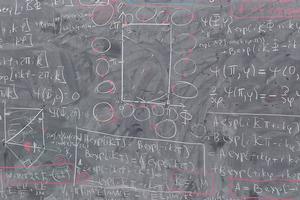Science
A Building Made for Collaboration

The Don Myers Technology and Innovation Building serves as an environment that fosters interdisciplinary collaboration between students and faculty. With the new building finished, the faculty celebrated with a welcome party. Mathematics and Statistics Professorial Lecturer Adam Knapp was assigned decorations. What else is a math professor to do for decorations other than draw topography knot pictures? When Physics Department Chair Nathan Harshman saw these decorations, he realized, with the help of the artist, that he could solve a previously unsolved problem in physics. He tracked down Knapp, and they started working together. This led to a fruitful interaction that culminated with the publication of an article in the journal Few-Body Systems, and another that is under submission.
Symmetry is found throughout nature, from sunflowers that follow the Fibonacci sequence to animals who have bilateral symmetry. By studying symmetry, Harshman strives to understand the limits of prediction and control for physical systems. In particular, he focuses on quantum mechanical models of ultracold atomic systems where symmetry, uncertainty and information can be quantified. One day, control of these systems will be advanced enough to enable new kinds of quantum technologies, such as computers and sensors. But first, more exploration into these systems is necessary. Harshman contributes to this exploration by studying systems that are at the ragged edge where symmetry fails to provide enough structure for prediction and control, where regularity and order dissolves into chaos. Harshman works at the atomic level, creating mathematical models for mixtures of particles to understand the foundations of energy, motion, matter, and information.
Professor Harshman joined the Department of Physics at American University in 2003. He first researched symmetry in relativistic particle scattering. Ultimately, he switched to quantum information theory applied to particle systems. To understand his research, it’s important to note the constraints symmetry has on what is possible. There are only five Platonic solids in three-dimensional space. A Platonic solid is a convex regular polyhedron in which all the faces have the same regular polygon and the same number of faces meeting at all its vertices. These Platonic solids can be found in the structures of molecules, crystals, games, and art. It’s important to understand all geometric possibilities. Harshman conveys this with the idea that, “one motivation is that any symmetric structures that one can derive from pure math end up being eventually found in nature. For example, math tells us that there are exactly 230 kinds of crystals in 3-D, and then we find these lattice patterns manifest in the physical arrangements of atoms and molecules in the structures and superstructures of solid matter. Nobel Laureate Eugene Wigner called this kind of thing the ‘unreasonable effectiveness of mathematics in the natural sciences…a gift we neither understand nor deserve.’” Applying these methods to quantum structures, Harshman can find the connection between symmetries and the conservation laws within quantum mechanics since Emmy Noether, Harshman’s personal hero, proved that symmetries imply conservations laws.
Since the opening of the Don Myers building, Harshman and Knapp have been working together, studying particles moving in one dimension that are experiencing three-body forces. Two-body forces depend on the distance between the two particles, but three-body forces are more complicated; they depend on the relative positions of three particles. The Schrodinger equation shows that mathematically three interacting particles in one dimension function the same as one particle in three dimensions that is experiencing external electric and magnetic fields. Using this knowledge, Harshman and Knapp can examine N particles interacting in D dimensions as one particle in Nd dimensions moving in a complicated background. With this information they can understand the force between three particles in the first dimension and relate it back to one particle in the third dimension.
Harshman and Knapp realized something interesting happening when the three-body interaction was “hard-core,” meaning the three particles cannot be on top of each other. They discovered that there are hard-core three-body interactions in one-dimension and this can cause the wave function to get twisted and form new types of particles called anyons. In three-dimensional space, all particles are either fermions (like electrons, protons, and neutrons; they obey the Pauli exclusion principle) or bosons (like photons and some atoms, which like to bunch together and can form lasers and Bose-Einstein condensates). Anyons can be found in two-body hard core interactions in two dimensions and have the same symmetry as braided strings. Harshman and Knapp were able to discover a new type of anyons that have a new kind of symmetry they call the traid group. They hope, after their work is published, that experimental physicists will try to measure these traid anyons, something that has never been done before. With the new Don Myers building and the environment it fosters, the AU STEM department is one step closer to understanding the complex components of the universe.
